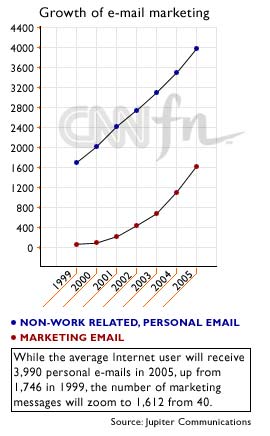|
Marketing 'rich' e-mails
|
 |
October 25, 2000: 10:55 a.m. ET
New strategies promise to deliver sophisticated messages to in-box
By Staff Writer Steve Bills
|
NEW YORK (CNNfn) - Forget Web sites. The next battleground for e-commerce is likely to be your e-mail in-box.
A bevy of competitors are coming to market with new strategies to connect with consumers, using increasingly sophisticated technologies to deliver their marketing messages and even more complex tracking systems to measure the effectiveness of those messages.
To John Sculley, the one-time chairman of Apple Computer (AAPL: Research, Estimates) who is now a venture capitalist, the changes now afoot in online marketing are reminiscent of the days when desktop publishing began to transform the printing industry.
 But this time around, "instead of looking like publishing, it will look more like television," said Sculley, who is chairman of an early mover in this new marketplace, a company called Gizmoz. But this time around, "instead of looking like publishing, it will look more like television," said Sculley, who is chairman of an early mover in this new marketplace, a company called Gizmoz.
Today, the number of players is mushrooming. When the advertising agency TBWA/Chiat/Day hosted a reception where Sculley spoke earlier in October, it attracted more than 80 CEOs from "rich media" companies.
"There are a lot of different companies that have e-mail programs, Java applets, relationship marketing programs," said Doug Jaeger, the agency's interactive creative director. "Agencies are being approached by all these different technology vendors, and they have no way to evaluate them."
Cashing in on the 'killer app' of the Internet
If competitors are flocking to the "rich media" space, it should be no surprise. In survey after survey, e-mail ranks as the "killer app" of the Internet, the tool that everybody uses. You may not trade stocks or even buy books over the Web, but everybody checks their e-mail.
"E-mail is one of the fast-growing areas in Internet advertising and marketing," said Christopher Todd, an analyst at market researcher Jupiter Communications. While the volume of personal e-mails for the typical Net user is likely to grow to 3,999 messages annually by 2005, from 1,746 in 1999, Jupiter predicts the number of marketing messages will soar 40-fold, to 1,612 messages from 40.
Until now, though, e-mail has been a rather bland marketing environment, limited to simple text messages or perhaps pages coded in HTML, the language of the Web. Broadband access promises to change all that.
"As the access speed improves," Todd said, "you will see companies like RadicalMail really take off."
Radical Communications of Marina Del Ray, Calif., is the developer of RadicalMail, which Chairman and CEO Bruce Stein promises will deliver "a more engaging, entertaining, immersive -- and simpler -- relationship with your customers."
At the heart of the Radical approach is a small applet written in the Java programming language and delivered via e-mail. When a user clicks on the mail icon to open the message, the action pings the Radical computer servers to deliver a video file, Flash animation, an audio clip like a pop song -- whatever the client wants to send. This content comes to life most often within the e-mail window.
"There's a whole lot more to the model than streaming content," Stein said. By monitoring the results in real time, a marketer can observe whether a customer, for instance, clicks through for an e-commerce transaction, and if the pitch is not working, can change it on the server, "so people who have not yet opened their e-mail will get the new content," Stein said -- the equivalent of changing the message after it is sent.
Such technology holds the promise of giving companies unprecedented access to information about their customers -- and raises the threat of unprecedented privacy intrusions. The marketer can tell, for instance, when clients open their e-mail, whether they stay with the streaming media file, and whether they follow through on a transaction.
As a result, the competitors are careful to emphasize that these e-mails are not unwanted "spam" spewed at random across the Internet. Instead, they say they rely on "opt-in" mailing lists and "permission-based" marketing programs, in which consumers request the information they send.
As more players come into the marketplace, they are struggling to find ways to distinguish themselves. One newcomer, High Speed Net Solutions of Raleigh, N.C., brags about its proprietary video-compression technology and a "sniffer" that automatically detects the speed of a user's Internet connection, adjusting the streaming automatically to deliver the best quality images.
"It might be a differentiator today. It will be a requirement down the road," said Gregory S. Gush, executive vice president and chief marketing officer. The company is now in "alpha testing" of its new video e-mail service and hopes to be attracting paying clients by the end of the year.
"It's an exciting time for us," Gush said. "I think this 'push' technology will change the world of marketing." 
|
|
|
|
|
 |

|

